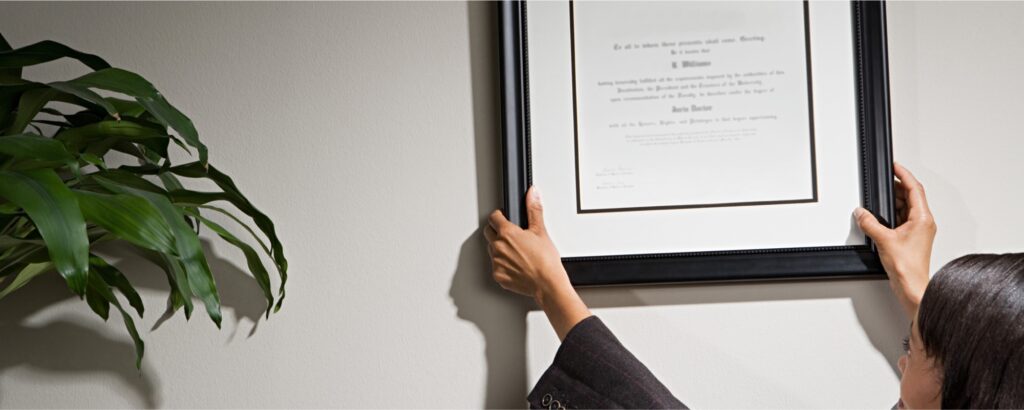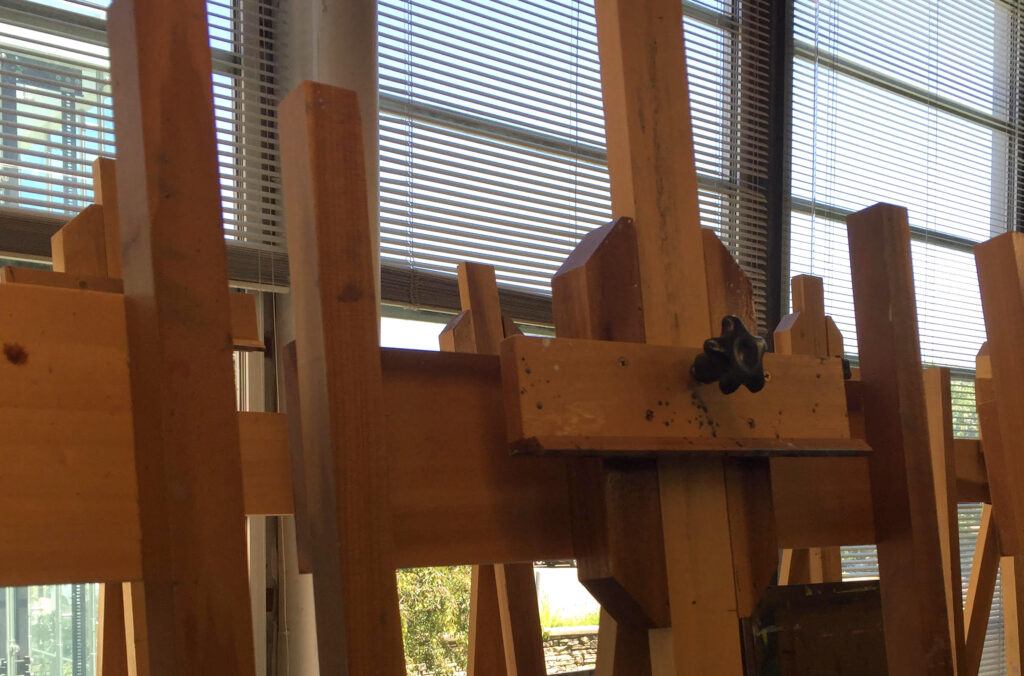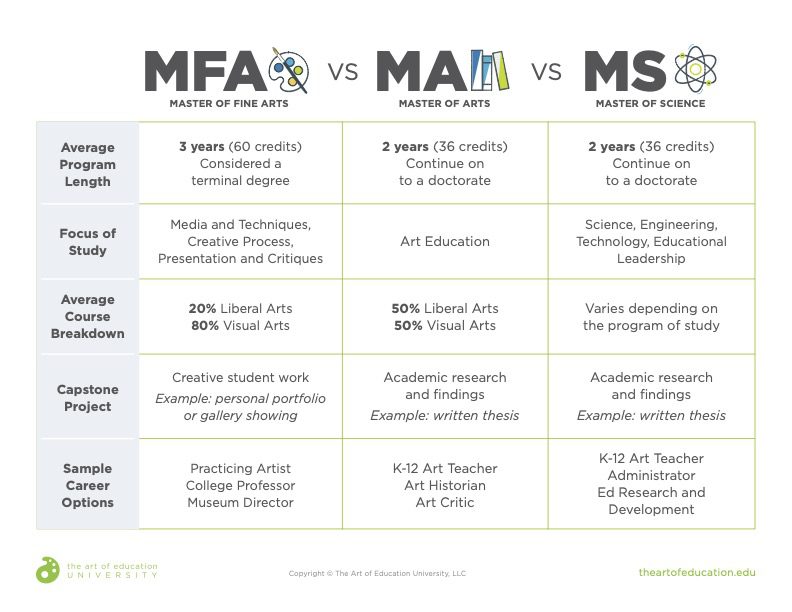There are many benefits to continuing your education including the opportunity to network with like-minded professionals, the chance to stay current with cutting-edge trends in the industry, and, of course, moving up on the pay scale! But when it comes to choosing a master’s degree program, there are many factors that deserve special consideration.
I had the opportunity to speak with a range of professionals in the field who are pursuing or have already earned a master’s degree in order to outline the differences between a Master of Fine Art (M.F.A.), a Master of Art (M.A.), and a Master of Science (M.S.). Today, I will discuss the key characteristics of these three graduate-level programs in an effort to provide the information you need to determine which program most closely aligns with your needs and educational goals.
Key Elements to Consider When Choosing a Master’s Degree

1. Program Length
Until recently, an M.F.A. was the highest degree offered in art education. These days, it is possible to earn a Ph.D. in Art Ed, although the programs are few and far between. Nevertheless, an M.F.A. is still considered a terminal degree while an M.A. and an M.S. are considered stepping stones toward a Ph.D.
On average, an M.F.A. takes about three years and requires the completion of around 60 graduate credits. Both an M.A. and an M.S. take about two years and require the completion of around 36 graduate credits.
Molly Wiste, an Adjunct Instructor at AOE, high school art teacher, and professional chainsaw artist, chose to earn her Master of Science (M.S.) degree. Although she admits the decision between an M.S. and an M.F.A. was not an easy one, it was the program length and time commitment that sealed the deal for her. She told me, “I am passionate about both art and education, so I would have been happy studying for my master’s in either area. Honestly, the main factor in choosing an M.S. over an M.F.A. was that to get an M.F.A., I was going to have to quit my job and go live in a studio. With a family, that was not an option. There are many schools in Minnesota that provide an M.S. in education with satellite locations. I got my M.S. in Educational Leadership from a school that is over five hours away because they had a cohort and professors an hour away from me. I met with them one weekend a month for two years.”

2. Focus of Study
The focus of study is the biggest difference between the three programs. Typically, an M.F.A. is centered around studio work. M.F.A. degrees are often focused on one artistic discipline, like sculpture or painting. Roughly 80% of coursework focuses on visual arts and the creative process including opportunities to present work and many critiques. Andrew McCormick, an Adjunct Instructor for AOE, Host of Art Ed Radio, and middle school art teacher, said the best part of earning his M.F.A. was, “…full-on studio immersion and the time and ability to really invest in my own creativity.”
On the other hand, an M.A. focuses on Art Education including best practices for the art classroom. M.A. degrees tend to be more research and theory based. Coursework includes about 50% visual arts curriculum, and 50% liberal arts curriculum, which provides an opportunity for personal focus areas. Patricia Christiansen, one of AOE’s Senior Instructors, earned her M.A. and plans to continue on. She commented, “One goal that I have for myself is to continue to grow professionally. I’m currently in the research phase for doctorate programs. I love being a student and learning with a cohort. It’s a personal goal to always strive to offer more to my students and the AOE community.”
Lastly, an M.S. is typically geared towards specialties relating to the sciences such as computer science, technology, engineering, etc. In the realm of education, it can also be used for more academic leadership roles outside of the classroom. Abby Schukei, AOE’s Social Media Manager and a member of the AOE Writing Team, earned her M.S. in Instructional Technology. She explained she pursued an M.S. because she was looking for a challenge outside of art education saying, “I wanted to gain new skills that I could bring into my art classroom, which led me to study computer science and technology.”

3. Capstone Project
A capstone project is a culminating task typically completed at the end of the earned degree. While capstone projects vary greatly depending on university requirements, M.F.A. students are more likely to focus on creative work by putting together a personal show or creating a professional portfolio. M.A. and M.S. students, in comparison, are more apt to focus on academics by developing a written thesis including action research and findings.
Developing a body of work was AOEU Adjunct Instructor, Haley Parker’s, favorite part about earning her M.F.A. Her passion shines through in this comment. “The best part of my graduate experience was seeing the change in myself as an artist. From the time I started to the time I completed my M.F.A., there was so much growth in my artwork. My paintings began to transform, and there was a visible difference in understanding the style of art I was creating. I wouldn’t trade the knowledge, instruction, and critique for anything. It is how I became the painter I am.”

4. Career Goals
Maybe the biggest consideration in deciding what type of master’s you want is how you plan on using your graduate degree. An M.F.A. is generally accepted for college studio professors, those wishing to hone their craft as professional artists, and museum directors. An M.A. is more typical of K-12 art teachers, college art education instructors, art historians, and those looking to continue on to a Ph.D. program. Similarly, an M.S. is more typical of a K-12 educator, administrator, or those planning to continue on with their post-graduate work.
The following graphic outlines the differences between an M.F.A., an M.A., and an M.S. in a side-by-side comparison. It can be downloaded as a PDF here.
As you can see, there are a lot of factors to consider as you choose your path in higher education. You’ll want to identify your passion and then balance that passion with practical concerns like time commitment and availability.
I’ll leave you with some great advice from AOE Content Specialist, Alecia Kaczmarek, who is currently pursuing her M.A. degree online, “Thoroughly research all options – don’t have buyers remorse. This is a big, expensive decision. It is hard work, and you have to have the time to commit to the courses. Also, communicate this time requirement to family and friends. I found that convenience, price, and choice in making the program my own (picking a Teacher Leadership strand and using my AOEU credits towards the program) helped me to make my decision.”
What type of master’s degree do you have?
How did you decide which program was the right one for you?
Magazine articles and podcasts are opinions of professional education contributors and do not necessarily represent the position of the Art of Education University (AOEU) or its academic offerings. Contributors use terms in the way they are most often talked about in the scope of their educational experiences.






